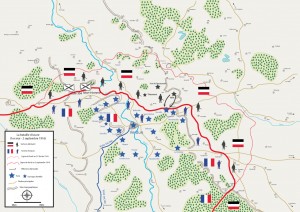On a battlefield where the ground shook again and again from the incessant pounding of artillery that resulted in 80 percent of human casualties, attacks and counterattacks succeeded one another without interruption.
Worrying over the scale of the Allied military preparations on the Somme, German General Staff launched a major attack on the left bank of the Meuse centred on Le Mort-Homme and Hill 304. They renewed their push on the right bank of the Meuse towards Fort Vaux that they encircled and captured on 7 June despite a heroic six days resistance by the French garrison and six failed counterattacks from the French Army. On the French side, General Mangin’s attempts to recapture Fort Douaumont on 22 May turned into a bloody defeat.
On June 23, the Germans launched a strong offensive on Fort Vaux and on the Thiaumont Redoubt that was to change hands sixteen times. It was on that day that the Germans used for the first time phosgene gas, a new kind of poisonous gas. As Allied preparatory bombardments on the Somme commenced on 24 June, the German General Staff realized that very little time remained to «liquidate» Verdun. On 11 July, following the failed attempt by German troops to capture Fort Souville, a strategic position that represented the ultimate phase of the German advance on Verdun, General Erich von Falkenhayn, Chief of the German General Staff, adopted a strict war policy of defence. As the Germans started moving forces towards the Somme, the combat zone around Verdun became quieter after the second half of July 1916.



Ajouter un commentaire